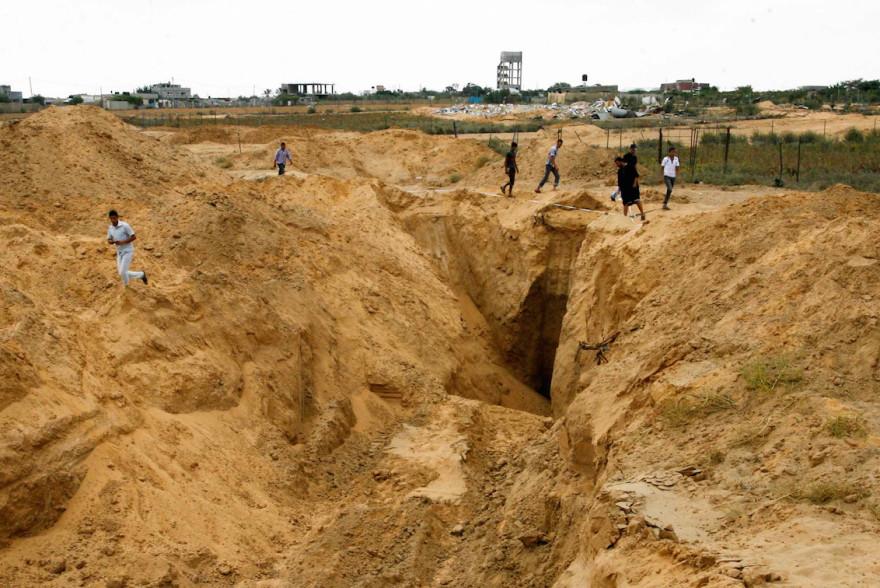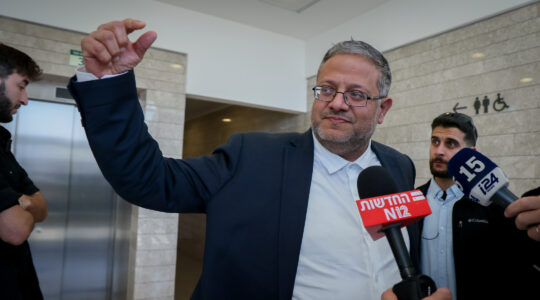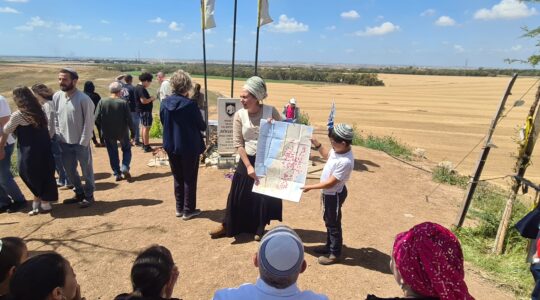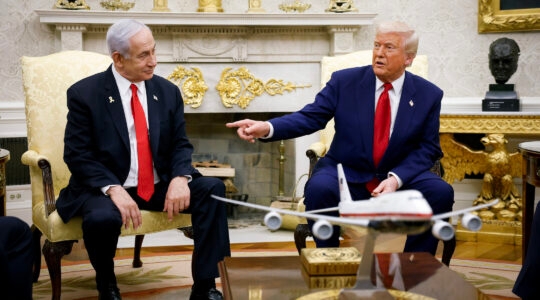
Palestinians viewing what used to be a tunnel leading from the Gaza Strip into Israel in the Rafah area of southern Gaza, Aug. 5, 2014. (Abed Rahim Khatib/Flash90)
OR YEHUDA, Israel (JTA) — Something that looks like a can of soda could be Israel’s high-tech answer to the network of tunnels that Hamas has created under the Gaza border.
A sensor known as a geophone can detect underground movement based on the sound generated by the movement, the Israeli defense firm manufacturing the device says. The firm, Elpam Electronics, says the geophone is capable of finding the location of a person crawling as far down as 32 feet.
Israel has grappled with the danger of the Gaza tunnels for years, but the threat has gained greater urgency in the wake of Protective Edge, the military operation launched last month. A ground invasion of Gaza that started five weeks ago had the stated aim of neutralizing the tunnels, 32 of which were subsequently destroyed, according to the Israeli military.
Now the mission is continuing in the research labs of Israeli defense firms. Both Rafael Advanced Defense Systems and, according to several Israeli reports, Elbit Systems are at work on systems to detect tunnels. Neither company would comment on their research.
But Elpam agreed to provide JTA with a look at the technology it’s been working on for decades and is now adapting to address the current threat.
Iky Koenig, Elpam’s CEO, wants Israel to bury hundreds of sensors in a constellation around the Gaza border. By next year the company hopes to have developed a monitoring system that can locate tunnel activity and differentiate it from other subterranean noise.
“Let’s say there’s a suspicion of activity from military intelligence or [the sound of] spoons digging,” Koenig said. “You put these things in the ground and if someone hears spoons, we’ll hear it like a bulldozer.”

An updated version of this system aimed at locating people trapped in the rubble of downed buildings could help Israel detect subterranean tunnels from Gaza. (Ben Sales)
In 1988, Elpam created its sensors to assist in search-and-rescue operations. The sensors were designed to detect sound frequencies in the ruins of destroyed buildings. Rescuers could hear people trapped under the debris and the trapped could respond. Dozens of the kits, which can fit inside a lightweight vest, were sold to the Israel Defense Forces.
Elpam also developed and sold two tunnel detection systems to the IDF in 2005 and 2006. One was intended to detect tunnels along the Philadelphi Corridor on the Egypt-Gaza border, but the company could not say whether the system was ever deployed.
In a statement to JTA last week, the IDF said it had considered two tunnel detection systems in 2005 and 2006 that were not effective. The IDF said it is now combining those systems and readying them for field testing.
The military expects deployment of the system to take one year and cost between $424 million and $565 million. The IDF would not confirm whether those systems were developed by Elpam.
The sensor concept is not without its critics.
Yiftah Shapir, a military technology expert at Tel Aviv University’s Institute for National Security Studies, said rows of sensors cannot detect tunnels that turn or intersections between multiple tunnels. Shapir also said the sensors do not have the ability to detect tunnel openings, which was among the key goals of the ground invasion.
“You think a tunnel starts in one place and ends in another,” he said. “There are three or four entrances. In the middle there are junctions. It’s never just in one place. [The IDF] went in essentially to look at where the other openings are.”
Atai Shelach, CEO of the defense firm Engineering Solutions Group, said the sensors will also have trouble pinpointing tunnels that are only a few feet wide. At best, he said, the technology will merely complement the military’s intelligence operations, not replace them.
“If [the sensor] will be effective at one point for a very great depth, it only solves a small part of the problem,” said Shelach, a former commander in the IDF Engineering Corps. “If it only finds one tunnel, that doesn’t mean that there aren’t other tunnels. Until there’s a broad solution, there won’t be a choice but to rely on intelligence.”
JTA has documented Jewish history in real-time for over a century. Keep our journalism strong by joining us in supporting independent, award-winning reporting.






